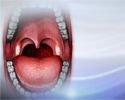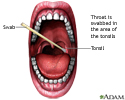Streptococcal screen
Rapid strep testA streptococcal screen is a test to detect group A streptococcus. This type of bacteria is the most common cause of strep throat.
Strep throat
Strep throat is a disease that causes a sore throat (pharyngitis). It is an infection with a bacteria called group A streptococcus.

How the Test is Performed
The test requires a throat swab. The swab is tested to identify group A streptococcus. It takes about 7 minutes to get the results.
How to Prepare for the Test
There is no special preparation. Tell your health care provider if you are taking antibiotics or have recently taken them.
How the Test will Feel
The back of your throat will be swabbed in the area of your tonsils. This may make you gag.
Why the Test is Performed
Your provider may recommend this test if you have signs of strep throat, which include:
- Fever
- Sore throat
- Tender and swollen glands at the front of your neck
- White or yellow spots on your tonsils
Normal Results
A negative strep screen most often means group A streptococcus is not present. It is unlikely that you have strep throat.
If your provider still thinks that you may have strep throat, a throat culture will be done in children and adolescents.
Throat culture
A throat swab culture is a laboratory test that is done to identify germs that may cause infection in the throat. It is most often used to diagnose ...

What Abnormal Results Mean
A positive strep screen most often means group A streptococcus is present and confirms that you have strep throat.
Sometimes, the test may be positive even if you do not have strep. This is called a false-positive result.
Risks
There are no risks.
Considerations
This test screens for the group A streptococcus bacteria only. It will not detect other causes of sore throat.
References
Allen CT, Nussenbaum B, Merati AL. Acute and chronic laryngopharyngitis. In: Flint PW, Francis HW, Haughey BH, et al, eds. Cummings Otolaryngology: Head and Neck Surgery. 7th ed. Philadelphia, PA: Elsevier; 2021:chap 61.
Bryant AE, Stevens DL. Streptococcus pyogenes. In: Bennett JE, Dolin R, Blaser MJ, eds. Mandell, Douglas, and Bennett's Principles and Practice of Infectious Diseases. 9th ed. Philadelphia, PA: Elsevier; 2020:chap 197.
Gigante J. Acute pharyngitis. In: Kliegman RM, St. Geme JW, Blum NJ, et al, eds. Nelson Textbook of Pediatrics. 22nd ed. Philadelphia, PA: Elsevier; 2025:chap 430.
Stevens DL, Bryant AE, Hagman MM. Nonpneumococcal streptococcal infections and rheumatic fever. In: Goldman L, Cooney KA, eds. Goldman-Cecil Medicine. 27th ed. Philadelphia, PA: Elsevier; 2024:chap 269.
-
Throat anatomy - illustration
Structures of the throat include the esophagus, trachea, epiglottis and tonsils.
Throat anatomy
illustration
-
Throat swabs - illustration
A throat swab can be used to determine if Group A Streptococcus bacteria is the cause of pharyngitis in a patient.
Throat swabs
illustration
-
Throat anatomy - illustration
Structures of the throat include the esophagus, trachea, epiglottis and tonsils.
Throat anatomy
illustration
-
Throat swabs - illustration
A throat swab can be used to determine if Group A Streptococcus bacteria is the cause of pharyngitis in a patient.
Throat swabs
illustration
Review Date: 3/16/2024
Reviewed By: Jatin M. Vyas, MD, PhD, Roy and Diana Vagelos Professor in Medicine, Columbia University Vagelos College of Physicians and Surgeons, Division of Infectious Diseases, Department of Medicine, New York, NY. Also reviewed by David C. Dugdale, MD, Medical Director, Brenda Conaway, Editorial Director, and the A.D.A.M. Editorial team.



